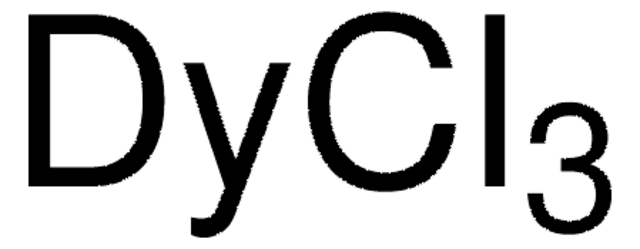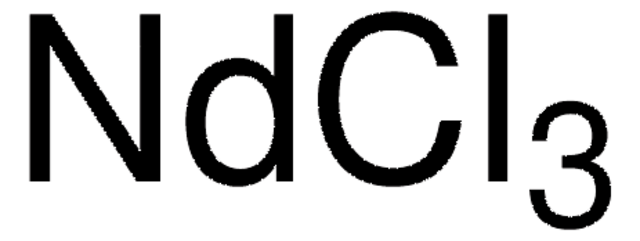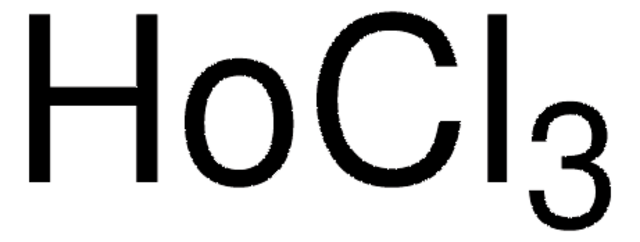Kluczowe dokumenty
289272
Dysprosium(III) chloride hexahydrate
99.9% trace metals basis
Synonim(y):
Dysprosium trichloride hexahydrate
About This Item
Polecane produkty
Poziom jakości
Próba
99.9% trace metals basis
Formularz
crystals and lumps
przydatność reakcji
reagent type: catalyst
core: dysprosium
zanieczyszczenia
≤2000.0 ppm Trace Rare Earth Analysis
ciąg SMILES
O.O.O.O.O.O.Cl[Dy](Cl)Cl
InChI
1S/3ClH.Dy.6H2O/h3*1H;;6*1H2/q;;;+3;;;;;;/p-3
Klucz InChI
HFEOHRWLEGXZHW-UHFFFAOYSA-K
Szukasz podobnych produktów? Odwiedź Przewodnik dotyczący porównywania produktów
Zastosowanie
- Synteza kompleksu dysprozu (III) z heksadentowanym ligandem aminowym: W tym badaniu zbadano syntezę nowego kompleksu dysprozu, podkreślając jego potencjalne zastosowania w dziedzinach takich jak magnetyzm molekularny i kataliza (Gonzalez-Barreira et al., 2023).
- Kompleks DyIII pentadentanowej zasady Schiffa z indukowanym polem magnetycznym pojedynczego jonu: Badania te opisują właściwości magnetyczne kompleksu dysprozu, przydatne do opracowywania nowych materiałów magnetycznych (Corredoira-Vazquez et al., 2023).
- Tetranuklearny kompleks Dysprosium Schiff Base wykazujący powolną relaksację magnetyzacji: Koncentruje się na syntezie i charakterystyce kompleksu opartego na dysprozie z potencjalnymi implikacjami w technologiach przechowywania danych (Gebrezgiabher et al., 2022).
- Samoorganizacja nanocząstek DyF3 syntetyzowanych metodą chlorkową: Badanie właściwości nanocząstek fluorku dysprozu syntetyzowanych przy użyciu heksahydratu chlorku dysprozu(III), istotnych dla różnych zastosowań nanotechnologicznych (Alakshin et al., 2018).
Hasło ostrzegawcze
Warning
Zwroty wskazujące rodzaj zagrożenia
Zwroty wskazujące środki ostrożności
Klasyfikacja zagrożeń
Eye Irrit. 2 - Skin Irrit. 2 - STOT SE 3
Organy docelowe
Respiratory system
Kod klasy składowania
11 - Combustible Solids
Klasa zagrożenia wodnego (WGK)
WGK 3
Temperatura zapłonu (°F)
Not applicable
Temperatura zapłonu (°C)
Not applicable
Środki ochrony indywidualnej
dust mask type N95 (US), Eyeshields, Gloves
Wybierz jedną z najnowszych wersji:
Masz już ten produkt?
Dokumenty związane z niedawno zakupionymi produktami zostały zamieszczone w Bibliotece dokumentów.
Klienci oglądali również te produkty
Produkty
The rare earth elements impact nearly everyone in the world. All of the people living in advanced technological countries and almost all those living in third world countries utilize the rare earths in their everyday living—the car that one drives (gasoline is refined from oil using rare earth catalysts and catalytic converters reduce the polluting emissions from the automotive exhaust), watching the news on TV (the red and green colors in TV screens), the telephones and computers we use to communicate (the permanent magnets in speakers and disc drives), just to name a few examples.
Nasz zespół naukowców ma doświadczenie we wszystkich obszarach badań, w tym w naukach przyrodniczych, materiałoznawstwie, syntezie chemicznej, chromatografii, analityce i wielu innych dziedzinach.
Skontaktuj się z zespołem ds. pomocy technicznej















